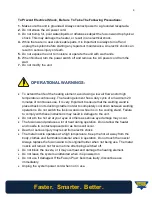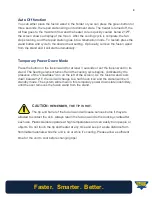
9
Faster. Smarter. Better.
Performing a repair
Pre-Operation:
1.
Clean the repair area with warm soapy and water, and/or plastic cleaner
2. Identify plastic by ISO code on panel being repaired
3. Read the TDS/SDS for the repair materials
4. Match the base material type with the corresponding repair plastic.
5. Secure the bumper cover on a parts stand or holder
Operation:
1.
Align the mating pieces together and secure with aluminum body tape on the front
side of the repair area.
2.
Confirm that the repair area is clean.
3.
On the backside, sand the repair area with the recommended grit. (80-120 grit
typically)
4.
Use a grinder to taper in a V-shaped groove on the backside of the repair.
5.
Set the fusion welder to the proper temperature for the plastic being repaired.
6.
Using the hot air, preheat the beginning area of the weld joint to the point where the
rod just begins to stick to the surface.
7.
Start the weld approximately 6 mm ahead of the weld joint using slight downward
pressure on the rod at a 90 degree angle to the repair surface. Allow the rod to flow
into the weld joint, using a side to side motion for the flat rod, or an up/down motion
for the round rod.
8.
Press the repair rod into the plastic moving at a rate that allows the liquefied plastic
to mix with the plastic being repaired. You should see a small wave of “wet” plastic
ahead of the rod, flowing into the weld joint
9.
Continue this process until both the width and length of the groove have been filled.
More than one pass may be required to fill the repair area.
10.
Allow the weld to cool.
11.
Sand and feather edge the area to the surrounding contour. (not required on the
backside if not visible)
Please visit
www.youtube.com
and search for
Fusion Plus Plastic Welder
for step by
step introduction on how to use this unit. If you have no access to the internet, please
use the step by step instruction found below:




























